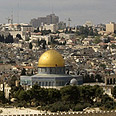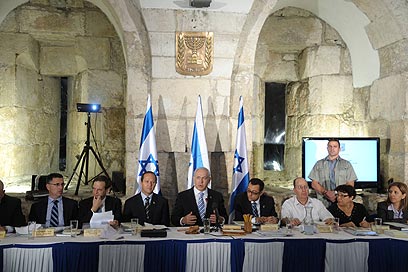Avital Lahav 06.01.11,
Israel's capital suffering from high unemployment rate, low percentage of high school graduates and too many families with only one breadwinner
In honor of Jerusalem Day, the Jewish people's eternal capital this week hosted a special Cabinet meeting, festive processions across the city and many performances.

The Central Bureau of Statistics offered its own gift– a compilation of data on Jerusalem's demographic, economic and social situation.
Quite a dubious gift, yet thought-provoking. The economic figures provide a painful reminder of what has been known for years: Jerusalem may be the center of the Jewish people in Zion, particularly in terms of politics and nationalistic slogans, but its financial situation does not match the statements on its status as Israel's most important city.

Cabinet meeting in Jerusalem (Photo: Amos Ben Gershom, GPO)
The employment rate in Jerusalem is not only lower than in Tel Aviv, but than in Israel's other big cities (Ashdod, Beersheba, Haifa and Petah Tikva) as well.
The capital's population has all the characteristics of a poor population – a high birthrate, high spending on basic food and low spending on outdoor dining, a low rate of high school graduates (less than half of the city's students), a low rate of adults who own a driver's license and a high percentage of households with only one breadwinner.
Jerusalem's average birthrate stands at four children per woman, compared to a national average of less than three children per woman.
According to the CBS figures, Jerusalem recorded the highest spending on meat and poultry in Israel in 2009, while the spending on outdoor dining stands at only NIS 244 (about $70.5) per month – compared to NIS 636 ($184) in Tel Aviv.
In 2009, only one in three Jerusalem residents had a driver's license – the lowest rate among Israel's big cities, and the spending on transportation was the highest in Israel – NIS 195 ($56) a month.
 Important but poor city (Illustration photo: Yaron Brener)
Important but poor city (Illustration photo: Yaron Brener)
The "classical" financial figures are not encouraging either. The number of unemployed people in Jerusalem is higher than the national average, and the labor force participation rate is particularly low (46% compared to 57.3% in all of Israel). As a result, the household consumption expenditure is lower than in other big cities.
The lack of means can be seen in almost every area. About 10% of the population in Jerusalem own two cars or more – the lowest rate among the six big cities. Only 66.2% of households in Jerusalem have a computer, compared to a national average of 77.4%.
The figures show that in spite of the State's massive investment in Jerusalem, the capital economic situation does not fit its status as Israel's most important city.
http://www.ynetnews.com/articles/0,7340,L-4076452,00.html
Israel's capital suffering from high unemployment rate, low percentage of high school graduates and too many families with only one breadwinner
In honor of Jerusalem Day, the Jewish people's eternal capital this week hosted a special Cabinet meeting, festive processions across the city and many performances.

The Central Bureau of Statistics offered its own gift– a compilation of data on Jerusalem's demographic, economic and social situation.
Quite a dubious gift, yet thought-provoking. The economic figures provide a painful reminder of what has been known for years: Jerusalem may be the center of the Jewish people in Zion, particularly in terms of politics and nationalistic slogans, but its financial situation does not match the statements on its status as Israel's most important city.

Cabinet meeting in Jerusalem (Photo: Amos Ben Gershom, GPO)
The employment rate in Jerusalem is not only lower than in Tel Aviv, but than in Israel's other big cities (Ashdod, Beersheba, Haifa and Petah Tikva) as well.
The capital's population has all the characteristics of a poor population – a high birthrate, high spending on basic food and low spending on outdoor dining, a low rate of high school graduates (less than half of the city's students), a low rate of adults who own a driver's license and a high percentage of households with only one breadwinner.
Jerusalem's average birthrate stands at four children per woman, compared to a national average of less than three children per woman.
According to the CBS figures, Jerusalem recorded the highest spending on meat and poultry in Israel in 2009, while the spending on outdoor dining stands at only NIS 244 (about $70.5) per month – compared to NIS 636 ($184) in Tel Aviv.
In 2009, only one in three Jerusalem residents had a driver's license – the lowest rate among Israel's big cities, and the spending on transportation was the highest in Israel – NIS 195 ($56) a month.
 Important but poor city (Illustration photo: Yaron Brener)
Important but poor city (Illustration photo: Yaron Brener) The "classical" financial figures are not encouraging either. The number of unemployed people in Jerusalem is higher than the national average, and the labor force participation rate is particularly low (46% compared to 57.3% in all of Israel). As a result, the household consumption expenditure is lower than in other big cities.
The lack of means can be seen in almost every area. About 10% of the population in Jerusalem own two cars or more – the lowest rate among the six big cities. Only 66.2% of households in Jerusalem have a computer, compared to a national average of 77.4%.
The figures show that in spite of the State's massive investment in Jerusalem, the capital economic situation does not fit its status as Israel's most important city.
http://www.ynetnews.com/articles/0,7340,L-4076452,00.html











No comments:
Post a Comment